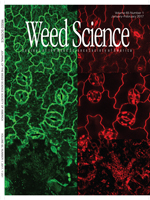Over the last 10 yr, California has experienced a series of ever-worsening droughts. Rice, traditionally a flooded crop, has come under increasing scrutiny with respect to its water use, leading to proposals to evaluate alternative irrigation systems. For growers, weed competition is one of the most limiting factors to maintaining high yields, so understanding the shifts among species in weed communities under the proposed alternative irrigation systems is vital. A field study was conducted from 2012 to 2014 to compare weed population and growth dynamics with three irrigation systems: (1) a conventional water-seeded control system (WS-Control), with a permanent flood of 10 to 15 cm from planting until 1 mo prior to harvest; (2) a water-seeded alternate wet and dry system (WS-AWD), with the field flooded from planting until canopy closure, after which floodwater was allowed to subside and the field was reflooded when the soil volumetric water content reached 35%; and (3) a drill-seeded alternate wet and dry system (DS-AWD), with rice drill seeded and then flush irrigated to establish the crop, after which the field was flooded until canopy closure and then underwent an alternate wet and dry (AWD) treatment similar to WS-AWD. In the AWD treatments, there were two drying periods, neither of which occurred after the heading stage. The dynamics of major weed species were evaluated using plant density counts (2012) and relative cover and biomass (2013 and 2014). Grasses (sprangletop and watergrass species) dominated the DS-AWD system; sedges, broadleaves, and grasses dominated both WS systems. The WS-AWD system increased smallflower umbrella sedge relative cover at canopy closure, relative dry weight at harvest, and percent frequency when compared with the WS-Control system. Yields did not differ across treatments when weeds were controlled (P > 0.05); in the absence of herbicides, yields in the WS-AWD were equivalent to the WS-Control (ranging from 40 to 65% of the herbicide-treated yields) and zero in the DS-AWD due to weed pressure.
Nomenclature: bearded sprangletop, Leptochloa fusca (L.) Kunth N. Snow; ducksalad, Heteranthera rotundifolia (Kunth) Griseb.; redstem, Ammannia coccinea Rottb.; ricefield bulrush, Schoenoplectus mucronatus (L.) Palla; smallflower umbrella sedge, Cyperus difformis L.; rice (Oryza sativa L.).





